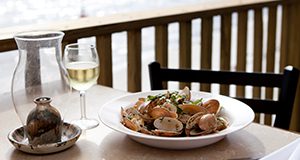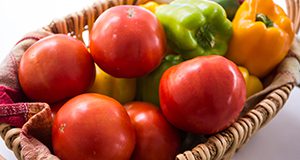Americans looking for an approach to healthy eating may want to consider the Mediterranean eating pattern. The Mediterranean eating pattern emphasizes fruits, vegetables, legumes, whole grains, nuts, and olive oil. It also includes moderate amounts of fish and poultry. This 3-page fact sheet discusses health benefits and ways to follow the Mediterranean eating pattern. Written by Sheila Rahimpour and Karla P. Shelnutt, and published by the UF/IFAS Department of Family, Youth and Community Sciences, May 2018.
http://edis.ifas.ufl.edu/fy1476
Tag: Karla P. Shelnutt
Healthy Living: Changing Your Lifestyle to Improve Your Blood Pressure
Most people know that high blood pressure can often be improved by making smart dietary choices and choosing foods lower in sodium. But did you know there are other ways to help control high blood pressure and even prevent it? This 4-page fact sheet is a major revision that discusses four lifestyle changes that can help you keep blood pressure down. Written by Karla P. Shelnutt and Linda B. Bobroff, and published by the UF/IFAS Department of Family, Youth and Community Sciences, revised February 2018.
http://edis.ifas.ufl.edu/fy1129
Raising Healthy Children: Age Five
This publication is designed to give you some information about the social, mental, and physical development of your five-year-old child. This new 5-page fact sheet discusses nutrition, eating behaviors, healthy food options, cooking activities, and physical activity. Written by Claire Marie Fassett and Karla P. Shelnutt, and published by the UF/IFAS Department of Family, Youth and Community Sciences, January 2018.
http://edis.ifas.ufl.edu/fy1475
Healthy Eating: Lowering Your Blood Pressure with DASH
One eating plan that has been shown to prevent and reduce high blood pressure is DASH. This 3-page fact sheet is a major revision that discusses the DASH eating plan, its importance, foods included in the eating plan, and servings. Written by Valerie Weyenberg, Karla P. Shelnutt, and Linda B. Bobroff, and published by the UF/IFAS Department of Family, Youth and Community Sciences, revised December 2017.
http://edis.ifas.ufl.edu/fy1128
Healthy Eating: Understanding the Nutrition Facts Label
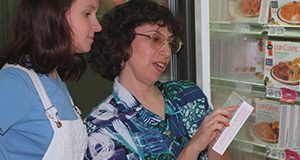 The U.S. Food and Drug Administration (FDA) requires that most food packages have the Nutrition Facts label. This label contains information about nutrients in the food to help people make healthier food choices. Older adults can use the label to choose foods that provide required daily nutrients or fit with a diet plan to manage a disease or health condition. This 4-page fact sheet is a major revision that discusses the Nutrition Facts label, checking calories, limiting certain nutrients, % Daily Values, and consuming enough fiber, vitamin D, potassium, calcium, and iron. Written by Linda B. Bobroff and Karla P. Shelnutt, and published by the UF Department of Family, Youth and Community Sciences, revised May 2017.
The U.S. Food and Drug Administration (FDA) requires that most food packages have the Nutrition Facts label. This label contains information about nutrients in the food to help people make healthier food choices. Older adults can use the label to choose foods that provide required daily nutrients or fit with a diet plan to manage a disease or health condition. This 4-page fact sheet is a major revision that discusses the Nutrition Facts label, checking calories, limiting certain nutrients, % Daily Values, and consuming enough fiber, vitamin D, potassium, calcium, and iron. Written by Linda B. Bobroff and Karla P. Shelnutt, and published by the UF Department of Family, Youth and Community Sciences, revised May 2017.
http://edis.ifas.ufl.edu/fy1127
Dietary Guidelines for Americans 2015–2020: A Summary
About half of all adult Americans have at least one chronic disease that could be prevented. Many of these preventable chronic diseases are related to poor eating and physical activity habits. The good news is that the risk of chronic diseases, such as heart disease, high blood pressure, and type 2 diabetes, can be reduced with the help of the 2015 Dietary Guidelines for Americans, which is described in this five-page fact sheet. Written by Kelly Johnston and Karla P. Shelnutt and published by the Food Science and Human Nutrition Department.
http://edis.ifas.ufl.edu/fs298
School Gardens: A Growing Part of Schools

School gardens have been popping up like little pea plants in schools all over Florida. Not only are they an excellent way to get fresh produce into classrooms and cafeterias, but they also provide students with a living classroom where concepts related to science, math, agriculture, and nutrition can be learned and applied. This 4-page fact sheet discusses the benefits of school gardens to children and teachers, different types of school gardens, and points to consider while planning. Written by Kohrine Counts and Karla P. Shelnutt, and published by the UF Department of Family, Youth and Community Sciences, February 2016.
http://edis.ifas.ufl.edu/fy1463
Healthy Living: Diabetes
Diabetes is a serious health condition that occurs when a person’s body has difficulty making or using insulin, which results in high blood glucose (blood sugar) and can lead to other complications. This 3-page facts sheet covers the effects of high blood glucose, who is at risk, the symptoms and management of the condition, and additional resources for those with or at risk of developing diabetes. Written by Linda B. Bobroff, Karla P. Shelnutt, and Paulina Wittkowsky, and published by the UF Department of Family Youth and Community Sciences, June 2015.
http://edis.ifas.ufl.edu/fy078
Facts about Farm to School
 Farm to school is a nationwide program that improves the supply of fresh, local produce to schools by building relationships between local farmers and schools. Over the past 20 years, school districts in all 50 states have joined the F2S program and are purchasing items from local farmers. Recent requirements for more fruit and vegetables in the National School Lunch Programs have made the F2S program more popular than ever. The University of Florida is committed to the Farm to School program and is working closely with the Florida Department of Agriculture and Consumer Services to connect farmers to schools. This 3-page fact sheet was written by Samantha Ward, Lauren Headrick, and Karla Shelnutt, and published by the UF Department of Family Youth and Community Sciences, December 2014. (Photo: iStock/Thinkstock.com)
Farm to school is a nationwide program that improves the supply of fresh, local produce to schools by building relationships between local farmers and schools. Over the past 20 years, school districts in all 50 states have joined the F2S program and are purchasing items from local farmers. Recent requirements for more fruit and vegetables in the National School Lunch Programs have made the F2S program more popular than ever. The University of Florida is committed to the Farm to School program and is working closely with the Florida Department of Agriculture and Consumer Services to connect farmers to schools. This 3-page fact sheet was written by Samantha Ward, Lauren Headrick, and Karla Shelnutt, and published by the UF Department of Family Youth and Community Sciences, December 2014. (Photo: iStock/Thinkstock.com)
http://edis.ifas.ufl.edu/fy1450
4-H Pizza Garden: An Agricultural Adventure
 This curriculum was designed for educators to teach young people about where their food originates by using something children love to eat…PIZZA! According to a recent Gallup poll, kids between the ages of 3 and 11 prefer pizza to all other foods for lunch and dinner. Americans eat about 100 acres of pizza each day, or 350 slices per second!This 4-H in the Classroom project, originating in Pinellas County, Florida, was designed for grades 3–5, but can be adapted to serve other grade levels. The lessons cover subject areas such as mathematics, social studies, language arts, and science. It has been used in Pinellas County very successfully since 2000 by the 4-H Program in collaboration with their Florida Ag in the Classroom Initiative. This 89-page fact sheet was written by Janet Golden, Joy Jordan, Nan Jensen, Betty Lipe, Millie Ferrer, Anne Fugate, Erin Karkheck, Linda Bobroff, Karla Shelnutt, and Tracy Tesdall, and published by the UF Department of 4-H Youth Development, November 2014.
This curriculum was designed for educators to teach young people about where their food originates by using something children love to eat…PIZZA! According to a recent Gallup poll, kids between the ages of 3 and 11 prefer pizza to all other foods for lunch and dinner. Americans eat about 100 acres of pizza each day, or 350 slices per second!This 4-H in the Classroom project, originating in Pinellas County, Florida, was designed for grades 3–5, but can be adapted to serve other grade levels. The lessons cover subject areas such as mathematics, social studies, language arts, and science. It has been used in Pinellas County very successfully since 2000 by the 4-H Program in collaboration with their Florida Ag in the Classroom Initiative. This 89-page fact sheet was written by Janet Golden, Joy Jordan, Nan Jensen, Betty Lipe, Millie Ferrer, Anne Fugate, Erin Karkheck, Linda Bobroff, Karla Shelnutt, and Tracy Tesdall, and published by the UF Department of 4-H Youth Development, November 2014.
http://edis.ifas.ufl.edu/4h356
Hydration Myths
 Whether at school, work, or running errands, it is common to see people sipping on their water bottles. This fashionable trend is a healthy one because water is essential for life. But while most people know that drinking water is good for them, many misconceptions exist about water and hydration. Learn the truth behind some of the most common hydration myths. This 4-page fact sheet was written by Lauren Caruso, Karla P. Shelnutt, and Gail Kauwell, and published by the UF Department of Family Youth and Community Sciences, August 2014.
Whether at school, work, or running errands, it is common to see people sipping on their water bottles. This fashionable trend is a healthy one because water is essential for life. But while most people know that drinking water is good for them, many misconceptions exist about water and hydration. Learn the truth behind some of the most common hydration myths. This 4-page fact sheet was written by Lauren Caruso, Karla P. Shelnutt, and Gail Kauwell, and published by the UF Department of Family Youth and Community Sciences, August 2014.
http://edis.ifas.ufl.edu/fy1409
Raising Healthy Children: Age Four
 As children continue their preschool years, they learn many new things and develop their own opinions and ideas. During this time, people inside and outside of the home may greatly influence them. As preschoolers continue to learn and grow, caregivers can take many steps to guide their children in a healthy and positive direction. This 4-page fact sheet was written by Kate Bennet, Gail Kauwell, and Karla P. Shelnutt, and published by the UF Department of Family Youth and Community Sciences, April 2014.
As children continue their preschool years, they learn many new things and develop their own opinions and ideas. During this time, people inside and outside of the home may greatly influence them. As preschoolers continue to learn and grow, caregivers can take many steps to guide their children in a healthy and positive direction. This 4-page fact sheet was written by Kate Bennet, Gail Kauwell, and Karla P. Shelnutt, and published by the UF Department of Family Youth and Community Sciences, April 2014.
http://edis.ifas.ufl.edu/fy1398
Raising Healthy Children: Promoting a Positive Feeding Experience
 All parents have heard “I don’t like that!” or “I’m not hungry!” from their child at some point or another. It’s likely that your child will not like every food that is served, but that doesn’t mean mealtime can’t still be a pleasant experience for the family. Parents may think they have sole responsibility for their child’s food choices, but Ellyn Satter, a registered dietitian who specializes in feeding and eating, advises that young children also have responsibility in the eating process. If feeding your child is stressful, read this fact sheet to learn about the division of responsibility in feeding and how to make meal times more enjoyable for the whole family. This 3-page fact sheet was written by Tiffany N. Stodtko, Karla P. Shelnutt, and Gail P.A. Kauwell, and published by the UF Department of Family Youth and Community Sciences, December 2014.
All parents have heard “I don’t like that!” or “I’m not hungry!” from their child at some point or another. It’s likely that your child will not like every food that is served, but that doesn’t mean mealtime can’t still be a pleasant experience for the family. Parents may think they have sole responsibility for their child’s food choices, but Ellyn Satter, a registered dietitian who specializes in feeding and eating, advises that young children also have responsibility in the eating process. If feeding your child is stressful, read this fact sheet to learn about the division of responsibility in feeding and how to make meal times more enjoyable for the whole family. This 3-page fact sheet was written by Tiffany N. Stodtko, Karla P. Shelnutt, and Gail P.A. Kauwell, and published by the UF Department of Family Youth and Community Sciences, December 2014.
http://edis.ifas.ufl.edu/fy1397
A Consumer's Guide to Eggs
 People have been eating eggs for centuries. Records as far back as 1400 BC show that the Chinese and Egyptians raised birds for their eggs. The first domesticated birds to reach the Americas arrived in 1493 on Christopher Columbus' second voyage to the New World. Most food stores in the United States offer many varieties of chicken eggs to choose from — white, brown, organic, cage free, vegetarian, omega-3 fatty acid enriched, and more. The bottom line is that buying eggs is not as simple as it used to be because more choices exist today. This 4-page fact sheet will help you understand the choices you have as a consumer, so you can determine which variety of egg suits you and your family best. Written by Jeanine Beatty, Karla Shelnutt, and Gail Kauwell, and published by the UF Department of Family Youth and Community Sciences, April 2013.
People have been eating eggs for centuries. Records as far back as 1400 BC show that the Chinese and Egyptians raised birds for their eggs. The first domesticated birds to reach the Americas arrived in 1493 on Christopher Columbus' second voyage to the New World. Most food stores in the United States offer many varieties of chicken eggs to choose from — white, brown, organic, cage free, vegetarian, omega-3 fatty acid enriched, and more. The bottom line is that buying eggs is not as simple as it used to be because more choices exist today. This 4-page fact sheet will help you understand the choices you have as a consumer, so you can determine which variety of egg suits you and your family best. Written by Jeanine Beatty, Karla Shelnutt, and Gail Kauwell, and published by the UF Department of Family Youth and Community Sciences, April 2013.
http://edis.ifas.ufl.edu/fy1357
Raising Healthy Children: Shellfish Allergies
 Learning that your child has a shellfish allergy can be scary. But having a plan and knowing how to treat and avoid a reaction to shellfish can ease this fear and keep your child safe. This publication explains shellfish allergies and provides information on the symptoms and how to respond if a reaction occurs. There are also tips to make it easier to manage your child’s shellfish allergy at home and away from home.This 4-page fact sheet was written by Kate Bennett, Karla P. Shelnutt, and Gail P. A. Kauwell, and published by the UF Department of Family Youth and Community Sciences, November 2013.
Learning that your child has a shellfish allergy can be scary. But having a plan and knowing how to treat and avoid a reaction to shellfish can ease this fear and keep your child safe. This publication explains shellfish allergies and provides information on the symptoms and how to respond if a reaction occurs. There are also tips to make it easier to manage your child’s shellfish allergy at home and away from home.This 4-page fact sheet was written by Kate Bennett, Karla P. Shelnutt, and Gail P. A. Kauwell, and published by the UF Department of Family Youth and Community Sciences, November 2013.
http://edis.ifas.ufl.edu/fy1402
Home Gardening Food Safety: Washing the Fruits (and Vegetables) of Your Labor Properly
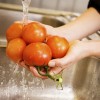 Having a home garden has become popular recently. It is a great way to enjoy fresh fruits and vegetables—foods that are an important part of a healthy diet. However, just because you have your own garden and control how it is treated does not make the fruits and vegetables you grow safer than those you buy in the store. To reduce the chance of getting sick from foodborne illnesses, you must wash the fruits and vegetables you grow before eating them raw or cooked. This publication helps you learn the proper way to clean your fruits and vegetables so you can enjoy them safely. This 4-page fact sheet was written by Eshani Persaud, Amy Simonne, and Karla P. Shelnutt, and published by the UF Department of Family Youth and Community Sciences, November 2013.
Having a home garden has become popular recently. It is a great way to enjoy fresh fruits and vegetables—foods that are an important part of a healthy diet. However, just because you have your own garden and control how it is treated does not make the fruits and vegetables you grow safer than those you buy in the store. To reduce the chance of getting sick from foodborne illnesses, you must wash the fruits and vegetables you grow before eating them raw or cooked. This publication helps you learn the proper way to clean your fruits and vegetables so you can enjoy them safely. This 4-page fact sheet was written by Eshani Persaud, Amy Simonne, and Karla P. Shelnutt, and published by the UF Department of Family Youth and Community Sciences, November 2013.
http://edis.ifas.ufl.edu/fy1401
Choose MyPlate: Enjoy Your Food But Eat Less
 Americans tend to select and consume larger portions than they need, and they don’t always make the best choices either. Part of the secret to maintaining a healthy diet is to know which foods to select and how to balance your intake with the amount of energy your body uses. This publication provides information about which foods make the healthiest contributions to our diets and which to limit. It also provides tips for making it easier to adjust your portions and to enjoy foods while making adjustments to your plate. This 4-page fact sheet was written by Ashley Hamm, Karla P. Shelnutt, and Gail P. A. Kauwell, and published by the UF Department of Family Youth and Community Sciences, November 2013.
Americans tend to select and consume larger portions than they need, and they don’t always make the best choices either. Part of the secret to maintaining a healthy diet is to know which foods to select and how to balance your intake with the amount of energy your body uses. This publication provides information about which foods make the healthiest contributions to our diets and which to limit. It also provides tips for making it easier to adjust your portions and to enjoy foods while making adjustments to your plate. This 4-page fact sheet was written by Ashley Hamm, Karla P. Shelnutt, and Gail P. A. Kauwell, and published by the UF Department of Family Youth and Community Sciences, November 2013.
http://edis.ifas.ufl.edu/fy1400
Understanding the New School Meal Standards
 If you have school-age children, you may have heard that the 2012 school year brought major changes to the meals children eat at school. All meals provided through the School Breakfast and National School Lunch Programs now must be consistent with the USDA’s Dietary Guidelines for Americans. This 6-page fact sheet was written by Jenna Norris, Karla P. Shelnutt, and Gail P. A. Kauwell, and published by the UF Department of Family Youth and Community Sciences, October 2013.
If you have school-age children, you may have heard that the 2012 school year brought major changes to the meals children eat at school. All meals provided through the School Breakfast and National School Lunch Programs now must be consistent with the USDA’s Dietary Guidelines for Americans. This 6-page fact sheet was written by Jenna Norris, Karla P. Shelnutt, and Gail P. A. Kauwell, and published by the UF Department of Family Youth and Community Sciences, October 2013.
http://edis.ifas.ufl.edu/fy1396
Understanding Gluten Sensitivity and Celiac Disease (FCS8028/FY1369)
 Several years ago, most people probably had never heard of gluten, but by 2011, gluten-free diets became more popular than low carbohydrate diets. One reason for this is the increased awareness and diagnosis of conditions in which gluten triggers an abnormal response in the body, such as gluten sensitivity and celiac disease. This 4-page fact sheet will help you learn about gluten sensitivity and celiac disease, as well as understand what they have in common and what is different about them. Written by Stephanie Meyer, Karla P. Shelnutt, and Gail P. A. Kauwell, and published by the UF Department of Family Youth and Community Sciences, April 2013.
Several years ago, most people probably had never heard of gluten, but by 2011, gluten-free diets became more popular than low carbohydrate diets. One reason for this is the increased awareness and diagnosis of conditions in which gluten triggers an abnormal response in the body, such as gluten sensitivity and celiac disease. This 4-page fact sheet will help you learn about gluten sensitivity and celiac disease, as well as understand what they have in common and what is different about them. Written by Stephanie Meyer, Karla P. Shelnutt, and Gail P. A. Kauwell, and published by the UF Department of Family Youth and Community Sciences, April 2013.
http://edis.ifas.ufl.edu/fy1369
Choose MyPlate: Reduce Your Sodium (FCS80027/FY1360)
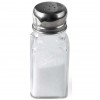 Reducing sodium intake is one of the MyPlate recommendations for healthy eating. Most Americans eat more sodium than they need, which can have negative health effects. This publication provides facts about sodium and why reducing sodium intake is important. It also provides easy tips to reduce your sodium intake. This 4-page fact sheet was written by Ashley Hamm, Karla P. Shelnutt, and Gail P. A. Kauwell, and published by the UF Department of Family Youth and Community Sciences, April 2013.
Reducing sodium intake is one of the MyPlate recommendations for healthy eating. Most Americans eat more sodium than they need, which can have negative health effects. This publication provides facts about sodium and why reducing sodium intake is important. It also provides easy tips to reduce your sodium intake. This 4-page fact sheet was written by Ashley Hamm, Karla P. Shelnutt, and Gail P. A. Kauwell, and published by the UF Department of Family Youth and Community Sciences, April 2013.
http://edis.ifas.ufl.edu/fy1360
